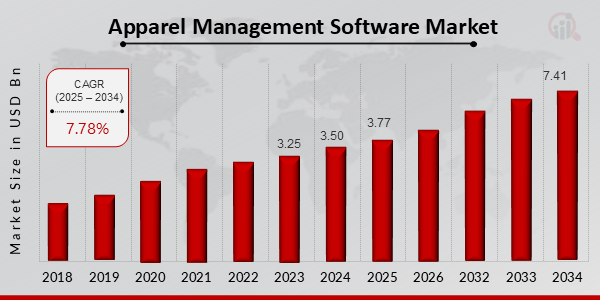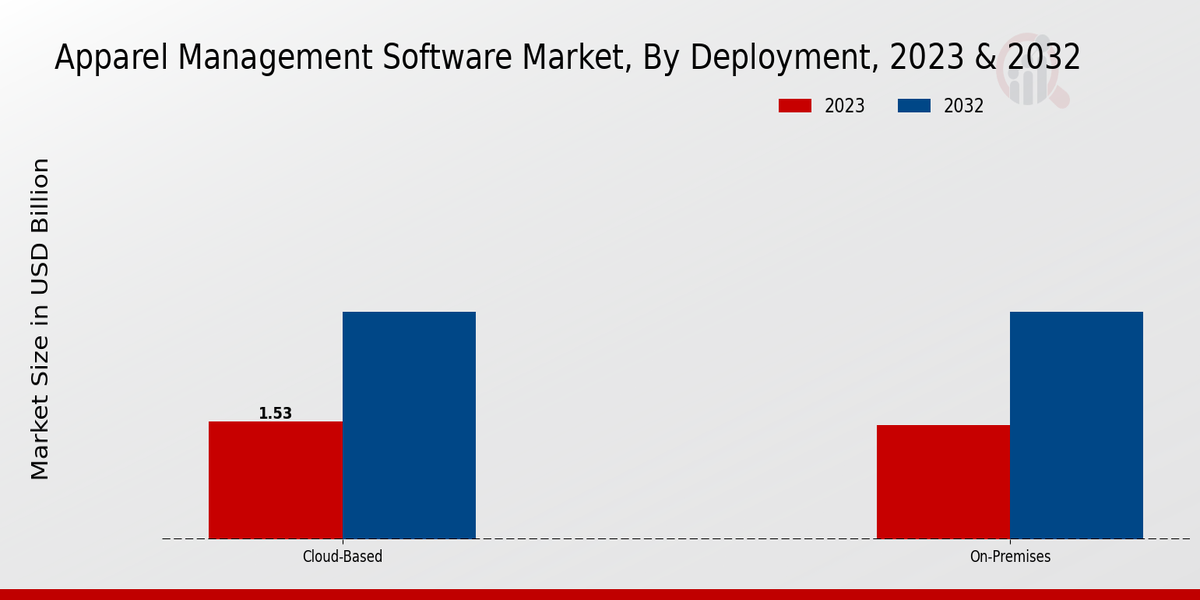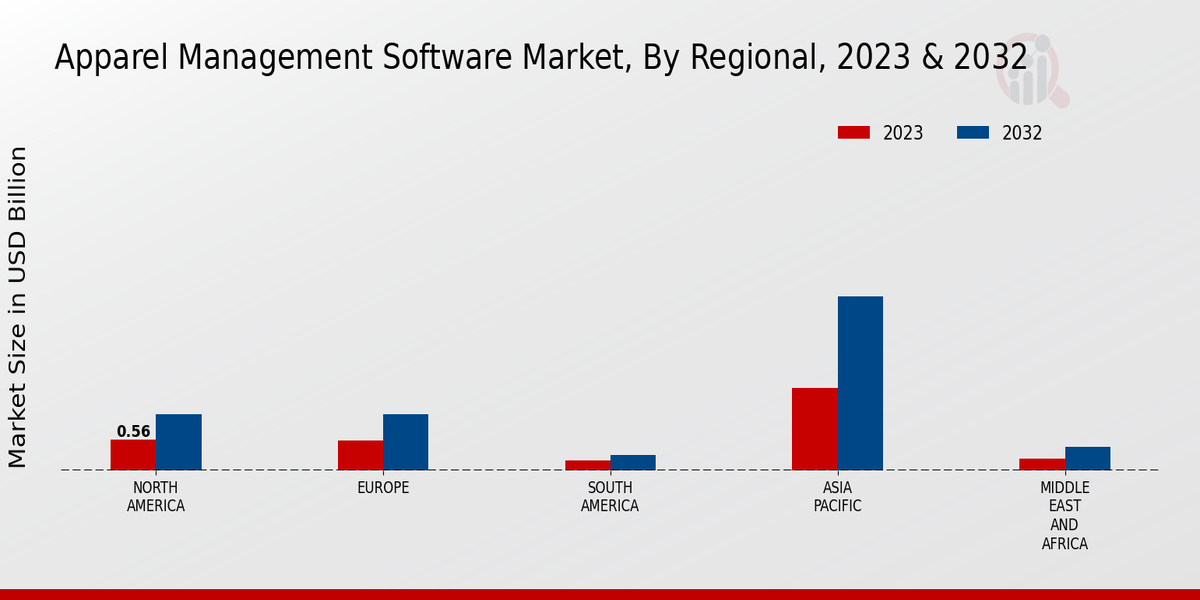Apparel Management Software Market Overview
Apparel Management Software Market is projected to grow from USD 3.77 Billion in 2025 to USD 7.41 Billion by 2034, exhibiting a compound annual growth rate (CAGR) of 7.78% during the forecast period (2025 - 2034). Additionally, the market size for Apparel Management Software Market was valued at USD 3.50 billion in 2024.
Key Apparel Management Software Market Trends Highlighted
The market of clothing management software is wide open for expansion. This is due to the increase in digitalization in the fashion business, growth of supply chain optimization and improvement in inventory management. In a bid to improve their operations as well as become more competitive, retailers and manufacturers are increasingly adapting fashion management software solutions. The best chances here involve including artificial intelligence (AI) and machine learning (ML) functions on these systems so as to back up advanced analytics, predictive modeling, and automatic decision-making.
With a greater emphasis on sustainability within the fashion industry, there is an increasing demand for software that encourages responsible sourcing, ethical manufacturing practices and circularity initiatives.
There have been recent developments in cloud-based offerings which provide flexibility, scalability, and reduced infrastructure costs. These applications are also mobile-enabled, thereby allowing real-time data access from anywhere and conducting transactions online. Consequently integration of online-to-offline channels has necessitated retailers’ adoption of all-inclusive software that bridges this gap between offline-physical stores and virtual-e-commerce platforms.
Figure 1: Apparel Management Software Market size 2025-2034

Source: Primary Research, Secondary Research, Market Research Future Database and Analyst Review
Apparel Management Software Market Drivers
Rising Demand for Efficient Supply Chain Management
Apparel trades are known for difficult supply chains consisting of various actors such as creators, producers, suppliers and sellers. Adequately managing these chains is indispensable for companies to secure timely order fulfillment, minimize costs and enhance customer satisfaction. This software improves the efficiency of the supply chain process in apparel by facilitating real-time information about stock levels, production calendar and direction of orders. Efficiency in production planning, decreasing lead times and improving relationships among supply chain partners are some of its utility.
Manufacturers can utilize this software to improve their responsiveness as well as their effectiveness in the global market by improving supply chain efficiency.
Growing Adoption of E-commerce and Omnichannel Retailing
The Apparel Industry is significantly impacted by the fast growth of e-commerce and the adoption of omnichannel retailing. As a result, today, clients expect to enjoy easy shopping across various channels, including online, offline, and mobile. Apparel management software helps in the implementation of omnichannel retailing as it provides solutions for inventory, orders, and customer management across all channels. In this way, companies could be sure that clients will receive the same data on products, prices, and promotion offers in any channel.
Therefore, the adoption of apparel management software helps to satisfy client’s needs and, as a result, boosts the demand for and revenue generated by companies in the Global Apparel Management Software Market Industry.
Increasing Focus on Sustainability and Transparency
Consumers today have started to realize the effect that the apparel industry has on the environment and society. Their awareness level has increased, and they now care about what goes into the clothes they buy and how they are produced. These are the demands businesses of today need to meet to stay afloat. Apparel management software helps companies monitor their ecological footprint and comply with regulations. They can also use the said software to demonstrate their concerns and measures they have taken to mitigate the negative implications on the environment.
Thus, apparel management software can help companies ensure transparency in their operations and enhance their images.
Apparel Management Software Market Segment Insights
Apparel Management Software Market Deployment Insights
The Global Apparel Management Software Market segmentation by deployment type comprises cloud-based and on-premises. Cloud-based deployment is projected to capture a significant share of the Global Apparel Management Software Market revenue during the forecast period, owing to its cost-effectiveness and accessibility. With cloud-based solutions, businesses can access software applications over the Internet without the need for on-site infrastructure. This eliminates the upfront costs associated with hardware and software installation and maintenance. Additionally, cloud-based software can be easily scaled up or down to meet changing business needs, making it an ideal solution for businesses of all sizes.
On-premises deployment, on the other hand, involves installing and maintaining software on physical servers located within the organization's premises. While this deployment type offers greater control and security, it can be more expensive and complex to implement and maintain. Organizations with stringent data security requirements or those that require customization of software applications may opt for on-premises deployment. Both cloud-based and on-premises deployment models have their own advantages and disadvantages, and the choice between the two depends on factors such as cost, flexibility, security, and customization needs.
Businesses should carefully evaluate their requirements and choose the deployment model that best aligns with their strategic objectives.
The competitive landscape of the Global Apparel Management Software Market is characterized by the presence of a number of established vendors as well as emerging players. Key industry participants include SAP SE, Oracle Corporation, Infor, IBM Corporation, and Microsoft Corporation, among others. These companies are continuously investing in research and development to enhance their product offerings and gain a competitive edge in the market.
The Global Apparel Management Software Market is poised for significant growth in the coming years, driven by the increasing adoption of cloud-based solutions and growing demand for integrated software solutions that can streamline operations and improve efficiency in the apparel industry.
Figure 2: Apparel Management Software Market , 2023-2032 (USD Billion)

Source: Primary Research, Secondary Research, Market Research Future Database and Analyst Review
Apparel Management Software Market Function Insights
The Global Apparel Management Software Market is segmented by its function into Inventory Management, Order Management, Product Development, and Supply Chain Management. The Inventory Management segment is expected to hold the largest market share in 2023 due to the growing need for businesses to track and manage inventory levels in real time. The Order Management segment is also expected to grow significantly as businesses look to improve their order fulfillment processes. The Product Development segment is expected to see strong growth due to the increasing demand for innovative and personalized products.
The Supply Chain Management segment is also expected to grow as businesses look to optimize their supply chains and reduce costs.
Apparel Management Software Market Industry Insights
The Global Apparel Management Software Market is expected to witness significant growth in the coming years. The market growth is attributed to the increasing adoption of apparel management software by various industries such as retail, apparel manufacturing, and fashion design. The growth of the segment can be attributed to the increasing adoption of apparel management software by retailers to improve their operational efficiency and customer service.
The apparel manufacturing segment is expected to witness a significant growth rate during the forecast period due to the increasing demand for apparel management software from apparel manufacturers to manage their production processes and supply chains. The fashion design segment is also expected to witness a healthy growth rate during the forecast period due to the increasing adoption of apparel management software by fashion designers to manage their design processes and collaborate with other stakeholders in the fashion industry.
Apparel Management Software Market Organization Size Insights
The Global Apparel Management Software Market is segmented by organization size into Small and Medium Businesses (SMBs) and Large Enterprises. The SMBs segment is expected to hold a significant market share in 2024 due to the increasing adoption of cloud-based apparel management solutions. SMBs are increasingly recognizing the benefits of apparel management software, such as improved efficiency, reduced costs, and enhanced customer service.
The Large Enterprises segment is also expected to grow steadily, driven by the need for comprehensive and integrated apparel management solutions. Large enterprises require advanced features and functionality to manage their complex supply chains and global operations. The Global Apparel Management Software Market is expected to grow from USD 3.02 billion in 2023 to USD 5.93 billion by 2032, at a CAGR of 7.78%.
Apparel Management Software Market Solution Type Insights
The Global Apparel Management Software Market is segmented by Solution Type into Standalone and Integrated Suite. The Standalone segment held the largest market share in 2023, accounting for around 60% of the Global Apparel Management Software Market revenue. The Integrated Suite segment is expected to grow at a faster CAGR during the forecast period. The Standalone solution is a single software application that is designed to perform a specific task, such as inventory management or order processing. It is typically less expensive than an integrated suite, but it may not offer the same level of functionality.
The Integrated Suite solution is a comprehensive software package that includes a variety of modules that can be used to manage all aspects of an apparel business, such as inventory management, order processing, customer relationship management (CRM), and financial management. It is typically more expensive than a standalone solution, but it offers a wider range of functionality and can help businesses to streamline their operations. The growth of the Integrated Suite segment is being driven by the increasing adoption of cloud-based solutions.
Cloud-based solutions are more affordable and easier to implement than on-premises solutions, and they offer a number of benefits, such as scalability, flexibility, and access to real-time data.
Apparel Management Software Market Regional Insights
The regional segmentation of the Global Apparel Management Software Market offers valuable insights into the market's dynamics across different regions. North America held the largest market share in 2023, accounting for approximately 35% of the Global Apparel Management Software Market revenue. The region's robust fashion industry, coupled with the presence of leading apparel brands and retailers, drives the demand for advanced apparel management software solutions. Europe is another significant region, contributing around 30% to the Global Apparel Management Software Market. Stringent regulations and a focus on sustainability in the apparel industry are key factors driving software adoption in the region.
The Asia-Pacific (APAC) region is projected to witness the fastest growth during the forecast period, with a CAGR of 8.5% from 2023 to 2032. The region's growing manufacturing sector, increasing consumer spending, and rising adoption of e-commerce platforms are fueling the demand for apparel management software. South America and the Middle East and Africa (MEA) regions are also expected to contribute to the Global Apparel Management Software Market growth, albeit at a slower pace compared to APAC.
Figure 3 : Apparel Management Software Market , 2023-2032 (USD Billion)

Source: Primary Research, Secondary Research, Market Research Future Database and Analyst Review
Apparel Management Software Market Key Players And Competitive Insights
Apparel Management Software Market Major Industry Players invest substantially in research and development to extend their product portfolios with advanced solutions meeting specific requirements. Leading companies concentrate their efforts on entering strategic partnerships, acquisitions, and collaborations to develop a wider presence in the market and increase their customer base. Also, the industry has recently experienced the rising popularity of such new technologies as artificial intelligence and machine learning that are expected to benefit market growth in the long period.
However, although apparel management software solutions providers experience a robust pace of market growth, the Apparel Management Software Market Competitive Landscape remains highly competitive in terms of both the active competition rate and the repeated introduction of new entries.
Infor is one of the most prominent companies currently operating in the Apparel Management Software Market. The company offers an integrated pool of apparel management software solutions comprising product lifecycle management, supply chain management, and enterprise resource planning systems. This way, Infor provides its customers with the extent of opportunities representing solutions, allowing different operations to be conducted. The principal goal the company strives to attain is assisting apparel industry organizations in streamlining operations and improving efficiency and controllability, as well as optimizing costs and expenses.
At the same time, SAP is one of Infor’s major competitors in the market. The company offers the latest SAP Apparel and Footwear Solutions, an extensive integrated package of solutions facilitating the completion of operations throughout the entire apparel lifecycle from the design and development stage to production and distribution. SAP solutions are supposed to predetermine the increase in apparel product quality, reduce lead times, and, therefore, enhance profitability. The company is particularly well-represented in the Asia-Pacific region and takes steps towards its market expansion in other regions.
Key Companies in the Apparel Management Software Market Include
Apparel Management Software Market Industry Developments
The global apparel management software market is projected to grow significantly from 2023 to 2032, driven by increasing demand for efficient supply chain management, inventory optimization, and customer relationship management in the apparel industry. The market is witnessing a rise in adoption of cloud-based solutions due to their flexibility, scalability, and cost-effectiveness. Additionally, the growing popularity of e-commerce is fueling the demand for robust apparel management software that can seamlessly integrate with online sales channels.
Furthermore, government initiatives to promote digitalization in the textiles and apparel sector are expected to provide impetus to market growth. Recent news developments include the acquisition of NedGraphics by PTC Inc. in 2023, which strengthens PTC's position in the apparel software market. Additionally, the partnership between Infor and Lectra in 2022 aims to provide end-to-end solutions for the fashion industry.
Apparel Management Software Market Segmentation Insights
-
Apparel Management Software Market Deployment Outlook
-
Apparel Management Software Market Function Outlook
-
Apparel Management Software Market Industry Outlook
-
Apparel Management Software Market Organization Size Outlook
-
Apparel Management Software Market Solution Type Outlook
-
Apparel Management Software Market Regional Outlook
|
Report Attribute/Metric
|
Details
|
|
Market Size 2024
|
3.50 (USD Billion)
|
|
Market Size 2025
|
3.77 (USD Billion)
|
|
Market Size 2034
|
7.41 (USD Billion)
|
|
Compound Annual Growth Rate (CAGR)
|
7.78% (2025 - 2034)
|
|
Report Coverage
|
Revenue Forecast, Competitive Landscape, Growth Factors, and Trends
|
|
Base Year
|
2024
|
|
Market Forecast Period
|
2025 - 2034
|
|
Historical Data
|
2019 - 2023
|
|
Market Forecast Units
|
USD Billion
|
| Key Companies Profiled |
iLend Retail, Assysten, Viarii, Lectra, SAP, Gerber Technology, Openbravo, Threadsol, Tukatech, IQMS Enterprise Manufacturing ERP, Yunique Solutions, Fibretone Technologies, Aptos, Infor, Cegid |
| Segments Covered |
Deployment, Function, Industry, Organization Size, Solution Type, Regional |
| Key Market Opportunities |
Growing demand for sustainability and transparency driven by consumer awareness of environmental and social issuesIncreased eCommerce adoption necessitating efficient inventory management and data analytics for accurate order fulfillmentCustomer relationship management CRM integration enables personalized marketing campaigns and tailored customer experiences.Artificial Intelligence AI and machine learning ML automate tasks and optimize processes for efficiency.Supply chain optimization, managing vendor relationships and streamlining order tracking for better visibility and collaboration |
| Key Market Dynamics |
Growing demand for inventory management toolsIncreasing adoption of cloud-based solutionsRising need for data analytics and reportingEmergence of AI and machine learning capabilitiesOmnichannel retailing driving market expansion |
| Countries Covered |
North America, Europe, APAC, South America, MEA |
Frequently Asked Questions (FAQ):
The Global Apparel Management Software Market is anticipated to reach a valuation of approximately 3.02 Billion USD in 2023.
The market is predicted to register a steady growth rate with a CAGR of around 7.78% over the forecast period.
North America is expected to dominate the Global Apparel Management Software Market throughout the forecast period, owing to the presence of established players and the rising adoption of advanced technologies.
Apparel Management Software finds applications across various aspects of the apparel industry, including product lifecycle management, inventory management, order management, and supply chain management.
Key players in the market include Infor, SAP, Oracle, Lectra, and Gerber Technology, among others.
The market is projected to reach a valuation of approximately 7.41 Billion USD by 2034, witnessing considerable growth over the forecast period.
Factors such as increasing demand for efficient inventory management, growing adoption of digital technologies, and rising focus on supply chain optimization are driving the growth of the Apparel Management Software Market.
The Asia-Pacific region is anticipated to witness the fastest growth rate during the forecast period, attributed to the growing apparel industry and increasing adoption of technology in the region.
Challenges include intense competition, integration complexity, and data security concerns.
Trends such as cloud-based solutions, artificial intelligence, and automation are expected to shape the future of the market.

















